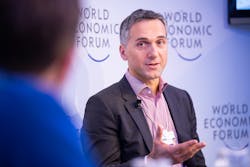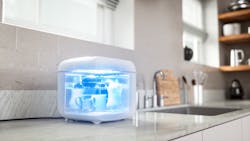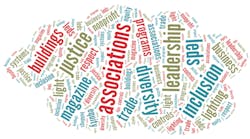It’s been over half a year since the lighting industry began ramping up ultraviolet C-band (UV-C) products aimed at ridding offices and homes of the novel coronavirus, yet the rumblings we’ve been picking up at LEDs Magazine suggest that uptake in the commercial market so far has trended more toward experimental one-off deployments rather than broad, full-scale commitments.
So our ears perked up recently when the boss of the world’s largest lighting company, Signify, addressed the issue during a conference call with analysts assembled online to discuss the year’s financial results and business performance.
Indeed, uptake in what Signify refers to as the “professional” market has required a bit of “education,” as CEO Eric Rondolat put it. But he expressed confidence that the company’s sales efforts will lead to wide-scale adoption of the technology in office places — even after the COVID-19 pandemic subsides. And, in contrast to the professional market, interest among home consumers has been more immediate, he indicated.
“On the professional side, we have a lot of wins, but it’s a much longer commercial cycle because we really need to educate a lot customers,” Rondolat said. “This is what our sales force centrally and locally are doing. The funnel is growing, with wins in different types of environments, especially in the retail environment.”
One of the customers that Signify has announced is German supermarket Edeka. True to form, though, Edeka has not ordered thousands of UV-C units to spread across the chain. Rather, it has installed 31 mercury vapor UV-C lamps at one location in Hamburg, where it has also installed a UV-C disinfection chamber to clean items such as barcode scanners. (See our list below of some deployments by Signify and other vendors.)
Rondolat spun the education challenge as a positive.
“It’s probably a hurdle to start the business, but it’s a good hurdle to have, because it’s going to be complicated for the competition to be able to do it,” he noted.
Furthermore, Rondolat refuted forecasts by some observers that interest in UV-C disinfection lighting will wane now that vaccines have arrived.
“We don’t see that,” he said, maintaining that the COVID-19 crisis has raised awareness of health, hygiene, and pathogens of all sorts — not just the SARS-CoV-2 virus, which causes COVID-19 — in a way that will boost long-term interest in disinfection productions such as UV-C.
“The way we are positioning the UV-C technology at this point in time is it’s not only for COVID. It’s in general to make sure that the spaces are clean, and we think it will survive the pandemic because the pandemic will leave sequels in our behavior.”
As has been his custom in calls with analyst and journalists over the last several months, Rondolat again declined to provide sales numbers for UV-C products. He reiterated that the product category is among the four areas that Signify has identified as growth sectors driven by an ethos of ecological sustainability. The other sectors are horticulture, solar, and 3D printing of luminaires.
Signify’s stable of UV-C products spans all of its three business divisions: the “Digital Solutions” division aimed at the professional market; the “Digital Products” division aimed at the home; and “Conventional,” which from a UV-C perspective comprises products Signify makes on an OEM basis for other companies. Its customers there are believed to include China’s Goldensea, which has provided UV-C disinfection to a couple of theaters in Spain.
All of Signify’s current UV-C products use mercury vapor technology rather than LED. That means that the UV-C products in the two digital divisions are not digital per se. Rather, they fit into systems that can have digital connections.
Signify began ramping up UV-C products in June, soon after it revealed that Boston University validated the effectiveness of Signify’s UV-C mercury vapor at deactivating SARS-CoV-2.
The company is now making nearly 10 times more UV-C products than it was a year ago, Rondolat told the analysts, noting that “we see a very strong traction on the sales of (UV-C) light sources.”
He also gave an upbeat assessment of UV-C sales into the home (Digital Products) market. There, in a development that LEDs had not yet reported on, he noted that Signify has been selling a disinfection box in Asia.
“We have seen an expansion of our sales to consumers,” Rondolat said. “We have released many products, like the disinfection box, which is the size of a small microwave, where basically you disinfect small objects —we’re talking about keys, phones, toys, things of that nature. We have started to sell in Asia, and we see good traction there.”
In another new development, Rondolat said the UV-C table lamp launched earlier in Asia and the Middle East is now available in Europe. The product has a sensor designed to switch off the lamp when people enter a room — UV-C is harmful to skin and eyes. The lamp “has done very well,” Rondolat said.
Back in the professional market, it should be noted that the commercial office business in general has been slow — not just for lighting — as companies have curtailed office use during the pandemic. It is something of a chicken-and-egg conundrum for UV-C. If more offices were operating, then sales opportunities would grow. But if more offices went for UV-C, then more offices would be operating.
To help strengthen its UV-C push into the commercial sector, Signify recently teamed with building systems specialist Honeywell.
Read more LEDs Magazine stories about UV-C deployments in the commercial sector
Crystal IS and Healthe team up to tackle coronavirus in sports application
Big Ass Fans makes big strides with UV-equipped air circulation products
Supermarket trials disinfection offerings to stop pathogens in their tracks
Soccer team scores COVID-fighting goals
Ultraviolet tech goes to the theater
MARK HALPER is a contributing editor for LEDs Magazine, and an energy, technology, and business journalist ([email protected]m).
For up-to-the-minute LED and SSL updates, why not follow us on Twitter? You’ll find curated content and commentary, as well as information on industry events, webcasts, and surveys on our LinkedIn Company Page and our Facebook page.







